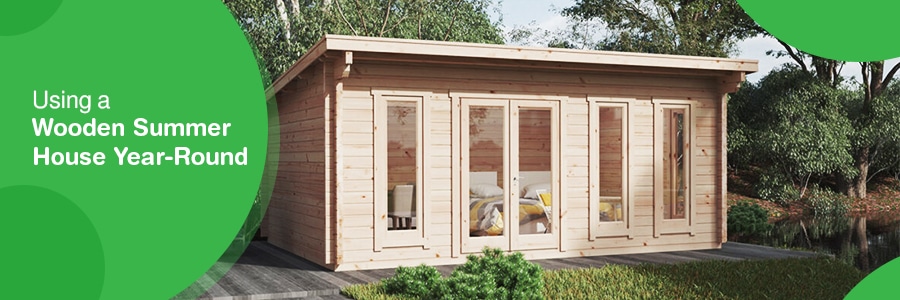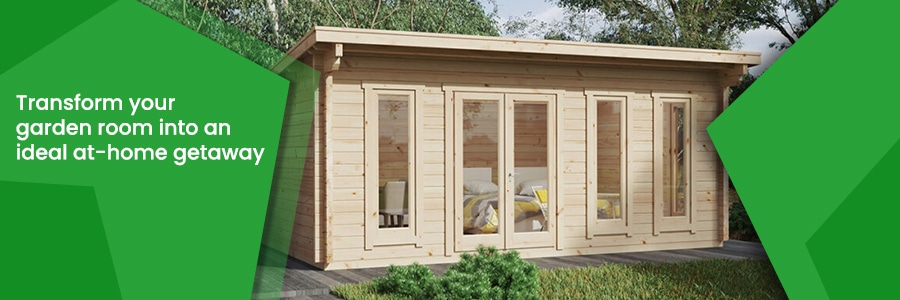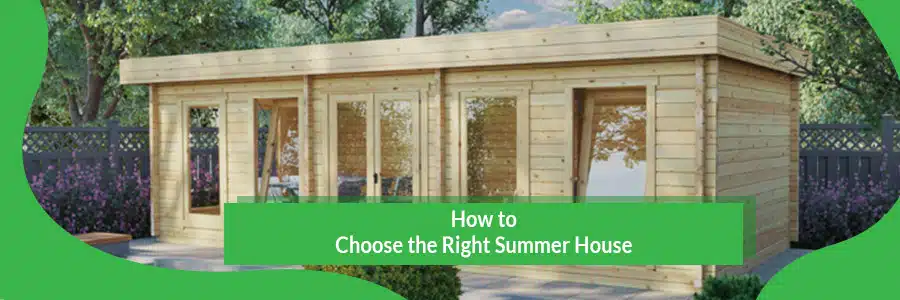How to use your summer house for gardening during the winter
29.11.2017
A summer house or a garden shed with windows can be used to hibernate frost-sensitive plants.
Every summer you care for your plants in the garden and gladly watch them grow and become more beautiful by the day. However, it is always an uncertainty if and how they will survive the winter.
I remember a beautiful Marguerite-tree at my childhood home that had to be hibernated every year. Where ever it was hibernated was not good for it. The cellar would have had a good temperature, but not enough light, a window in the house would give enough light, but it would be much too warm. So after cutting it back to the “wood” each fall, it grew some kind of light-green “inside-leafs” that would die off every year as soon as it would be put outside again.
During the summer it grew back into a big round ball of daisies again. I loved that little tree, and I wished we would have had a place like a summer house with large windows and a frost guard that would keep the temperature just above zero. The low temperatures would lead to very slow growth, if at all, and the light would make the little leaf buds or even fresh small leaves dark green and fit to continue growth as soon as the plant would be outside again.
In the following article we want to show you what could you do with a frost-free summer house and some light through a window.
A frost-free summer house can help not only with hibernation but also with early propagation
An insulated summer house with an electrical frost-guard that would start heating as soon as the temperature gets close to zero, and with nice large double-glazed floor to ceiling windows could easily be used as a greenhouse.
Even garden sheds with smaller windows would do the trick when you just put a table under the window or make a large inner window sill to put the plants on. Such a space can also be used to sow out crops early like cabbage, spinach, lettuce, kohlrabi, beetroot, or carrots. These could be sowed as early as February inside the frost-free summer house while heat-loving crops like tomatoes, chillis, or peppers would enter the early cultivation only in the middle of March to be planted out into the garden around the summer house in the middle of May.
Ornamental gardeners can sow sun flowers, heliotrope, begonias, or petunias between January and March at the early-cultivation station inside the summer house.
That way you could easily expand the natural gardening period by two months.
Of course, such a place would also be perfect to grow fresh herbs for cooking and salads all year round or to cultivate micro greens all through the wintertime when fresh greens with their vitamins and minerals are much-needed for salads, smoothies, as a side dish or as a decoration on any meal including the morning toasts.
Hibernation of frost-sensitive species in the summer house
Tubers of begonias are very frost-sensitive and need to be hibernated at any cool and frost-free place, for example in the summer house. You can cut the stems 3 inches above the ground, dig the tubers out and dry them inside. After that, you can clean the tubers from stems, roots, and dirt and hibernate them in soil or turf.
Dahlias or gladiolas can be treated similarly. You could use the digging for the tubers to plant some snowdrops or crocuses in the process so you will have some very early flowers and at the same time you will be forced to look for some new places for the tubers next season, so they will profit from some fresh soil.
If there is enough light in your summer house, then potted plants like mallows, lemons or any citrus plants, hibiscus, rosemary, oleander, marguerite, or bougainvillea will just be there in the light. These species can also be cut back before you put them inside the summer house.
Frost-sensitive plants that lose their leaves in fall like pomegranates, plumbagos, or fuchsias could hibernate at any cold place. You could place them in some darker corners inside the summer house or even into the cellar.
While working outside during the fall, please remember to remove the fallen leaves from the gutters and drainage of your summer house. You can make use of the foliage by mulching berries or fruit trees with it or put a thick layer over the tubers of your frost-sensitive flowers if you don’t want to dig them out. If the winter is not too hard, that will work as well.
Should the summer house be insulated if used just for hibernation?
While you could use any summer house with a wall-thickness of at least 40mm for this purpose, we would recommend an additional insulation just to spare some money for the electricity bill. This may require some spending and one or two days of work, but it will reduce the costs of heating even if it will only keep the summer house frost-free forever.
Our summer houses with wall-thicknesses over 40mm are all with double tongue and groove, so the walls will be tight and already represent an excellent thermal insulation value. Days below zero are also limited so that the frost-guard will only become operational on special occasions and it won’t have to raise the temperature that much.
All in all, it is up to you if you want to insulate your summer house for the purpose of hibernating plants or for early cultivation. If you decide for an insulation, we have put up a manual for you about how to insulate your summer house.
Plants inside the summer house will need very little watering. Make sure that the pots are in trays, and check that there is no water between the trays and the wooden floor. Maybe it would be a good idea to put the pots on a larger piece of foil or vinyl.
Categories:
How ToWant to discuss over phone. Let us call back to you
If you need any additional info regarding any product, please fill in the below form and we will get back to you, usually the same or next working day.
Have any questions regarding some product?
If you need any additional info regarding any product, please send us your questions.



